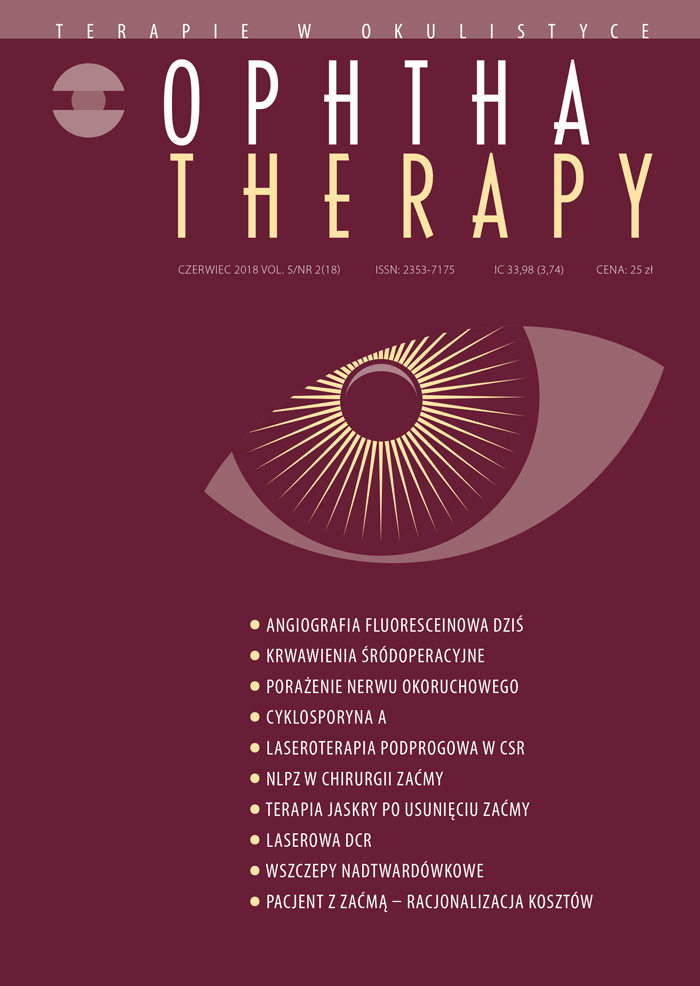Laser dacryocystorhinostomy – the lasers use in treatment of lacrimal duct obstruction
Main Article Content
Abstract
Obstruction of the nasolacrimal duct, impeding the proper outflow of tears from the conjunctival sac to the nasal cavity, is a common disorder that is clinically manifested as tearing. Dacryocystorhinostomy is the creation of a direct fistula between the tear sack and the nasal cavity. The surgical approach may be external or endoscopic with or without a laser. Laser dacryocystorhinostomy is now a recognized procedure for the treatment of lacrimation resulting from nasal-lacrimal duct obstruction. The method has many advantages over conventional treatment. These advantages include: the absence of external scars, the possibility of simultaneous treatment of nasal cavity pathology, sparing of the medial lining of the eyelids, intact tear pump mechanism. The laser treatment time is also shorter with a comparable success rate to classic surgery. The introduction of a laser for tear-ditch surgery made it possible to treat tear-lacrimal obstruction in a simpler and less invasive way.
Downloads
Article Details

This work is licensed under a Creative Commons Attribution-NonCommercial-NoDerivatives 4.0 International License.
Copyright: © Medical Education sp. z o.o. License allowing third parties to copy and redistribute the material in any medium or format and to remix, transform, and build upon the material, provided the original work is properly cited and states its license.
Address reprint requests to: Medical Education, Marcin Kuźma (marcin.kuzma@mededu.pl)
References
2. Pecold K, Krawczyński M (ed). Basic and Clinical Science Course. Część 7. Oczodół, powieki i układ łzowy. Elsevier Urban & Partner, Wrocław 2005: 267-70.
3. Spaeth GL. Chirurgia okulistyczna. Elsevier Urban & Partner, Wrocław 2006: 561-679.
4. Hartikainen J, Antiila J, Varpula M et al. Prospective randomized comparison of endonasal endoscopic dacryocystorhinostomy and external dacryocystorhinostomy. Laryngoscope. 1998; 108: 1861-6.
5. West JM. A Window Resection of the Nasal Duct in Cases of Stenosis. Trans Am Ophthalmol Soc. 1910; 12(Pt 2): 654-8.
6. McDonogh M, Meiring JH. Endoscopic transnasal dacryocystorhinostomy. J Laryngol Otol. 1989; 103(6): 585-7.
7. Wielgosz R, Mroczkowski E. Mikrochirurgia wewnątrznosowa dróg łzowych: modyfikacja dacryocystorhinostomii. Otolaryngologia Polska, Polish Journal of Otolaryngology. 2005; LIX(6): 825-31.
8. Rice DH. Endoscopic intranasal dacryocystorhinostomy: a cadaver study. Am J Rhinol. 1988; 2: 127-8.
9. McDonogh M, Meiring JH. Endoscopic transnasal dacryocystorhinostomy. J Laryngol Otol. 1989; 103: 585-7.
10. Tsirbas A, Wormald PJ. Endonasal dacryocystorhinostomy with mucosal flaps. Am J Ophtalmol. 2003; 135: 76-83.
11. Broda M, Białas D, Różycki R. Współczesne metody operacyjnego leczenia niedrożności dróg łzowych u dorosłych. Ophthatherapy. 2017; 2(14): 36-41.
12. Massaro BM, Gonnering RS, Harris GJ. Endonasal laser dacryocystorhinostomy. A new approach to nasolacrimal duct obstruction. Arch Ophtalmol. 1990; 108: 1172-6.
13. Rosen N, Barak A, Rosner M. Transcanalicular laser-assisted dacryocystorhinostomy. Ophtalmic Surg Lasers. 1997; 28: 723-6.
14. Holak H. Zastosowanie własnej metody stentowania w leczeniu niedrożności dróg łzowych przezkanalikową metodą z użyciem lasera THC:YAG. Akademia Medyczna im. Piastów Śląskich, Wrocław–Salzgitter 2007.
15. Nagashima K, Araki K. On the lacrimal part of the orbicularis oculi muscle with special reference to the sac dilators. Jap J Ophthalmol. 1963; 102: 1634-49.
16. Sadiq SA, Ohrlich S, Jones NS. Endonasal laser dacryocystorhinostomy medium term results. Br J Ophthalmol. 1997; 81: 1089-92.
17. Szubin L, Papageorge A, Sacs E. Endonasal laser-assisted dacryocystorhinostomy. Am J Rhinol. 1999; 13: 371-4.
18. Velegrakis GA, Prokopakis EP, Panayotaki I et al. Intranasal laser-assisted dacryocystorhinostomy with the use of a surgical microscope. Am J Otolaryngol. 2002; 23: 272-6.

